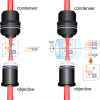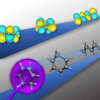Spectroscopy News
A new optical spectroscopy technique developed by researchers at Lawrence Livermore National Lab promises to improve accuracy and lower costs of real-time assessment of kidney function.
Stimulated Raman projection microscopy and tomography using a special type of laser beam to penetrate deep into tissue might lead to technologies that eliminate the need to draw blood for analyses including drug testing and early detection of diseases such as cancer and diabetes.
A research team at Osaka University has developed an approach to increase the resolution of multichannel spectrometers.
Researchers at Northwestern University have created a new method (gradient-assisted multi-dimensional electronic Raman spectroscopy) to extract the static and dynamic structure of complex chemical systems. This new method uses four spectral dimensions to resolve structure to reveal hidden features of molecular structure.
The study of jet disintegration focuses on fuel breakup and mixing within the combustion chamber of propulsion devices. A team of researchers at the University of Florida have applied spectroscopic diagnostics techniques to learn more about the fundamentals of sub- and supercritical jet disintegration.
Titanium dioxide (TiO2) is one of the most promising materials for photovoltaics and photocatalysis nowadays. This material appears in different crystalline forms, but the most attractive one for applications is “anatase”. EPFL scientists have now shed light onto the problem by a combination of steady-state and ultrafast spectroscopic techniques, as well as theoretical calculations.
Electron movements in a transient state of a reaction important in biochemical and optoelectronic processes have been captured and, for the first time, directly characterised using ultrafast X-ray spectroscopy at the Department of Energy’s Lawrence Berkeley National Laboratory.
TOPTICA Photonics and Menlo Systems have entered into a license agreement for the use of patented frequency comb technology.
The WADI project is using hyperspectral, multispectral and thermographic infrared imaging to detect soil moisture and those leaks from water mains in rural areas.
Quantum mechanics dictates how particles and forces interact, and thus how atoms and molecules work, for example, what happens when a molecule goes from a higher-energy state to a lower-energy one. But beyond the simplest molecules, the details become very complex. Now, a Pixel-Imaging Mass Spectrometry camera and a femtosecond vacuum ultraviolet light source are showing how does quantum mechanics work in larger, more complex systems.
Salmon is one of the most popular edible fish of all. Shops sell fish caught in the wild, but their main produce is salmon from breeding farms, the effluent from which can pollute rivers, lakes and oceans. German and Chilean scientists have used fluorescence measurements, high-resolution mass spectrometry and nuclear magnetic resonance spectroscopy to answer this question.
Lewis E. Kay is to receive a 2017 Canada Gairdner Award for his contributions to the field of biomolecular NMR spectroscopy.
numares AG and Oxford University are collaborating to develop an nuclear magnetic resonance (NMR)-based in vitro diagnostic (IVD) test to improve therapeutic decision making for patients with multiple sclerosis (MS). This is based on research conducted at Oxford to differentiate MS patients by metabolic biomarkers using NMR spectra. numares will provide its Magnetic Group Signaling® (MGS®) technology to Oxford to advance research toward the creation of a non-invasive diagnostic test.
Drugs containing gold have been used for centuries to treat conditions like rheumatoid arthritis. In addition, they can be effective against cancer and HIV. One mechanism by which they work could occur because gold ions force the zinc ions out of zinc fingers—looped, nucleic acid binding protein domains. American researchers have characterised such “gold fingers” using ion mobility mass spectrometry and identified the exact gold binding sites.
Chemists from the University of Konstanz have used electron paramagnetic resonance spectroscopy to prove what happens when selective mutations occur to alpha-synuclein protein.
The 2017 Tomas Hirschfeld Award has been made to Satoru Tsuchikawa of Nagoya University, Japan.
Infrared spectroscopy images provide new insight into the development of plaques in early-stage Alzheimer’s disease.
University of Sydney researchers have used infrared spectroscopy to spotlight changes in tiny cell fragments called microvesicles to probe their role in a model of the body’s immunological response to bacterial infection.
Researchers at Lancaster University have used infrared spectroscopy to detect subtle early warning signs that reveal a frog population is at risk from pollution.
Given the increase in food-related health problems, the challenge set for the EU Horizon’s Food Scanner prize of €1 million was to develop an affordable and non-invasive mobile solution that enables users to measure and analyse their food intake.














